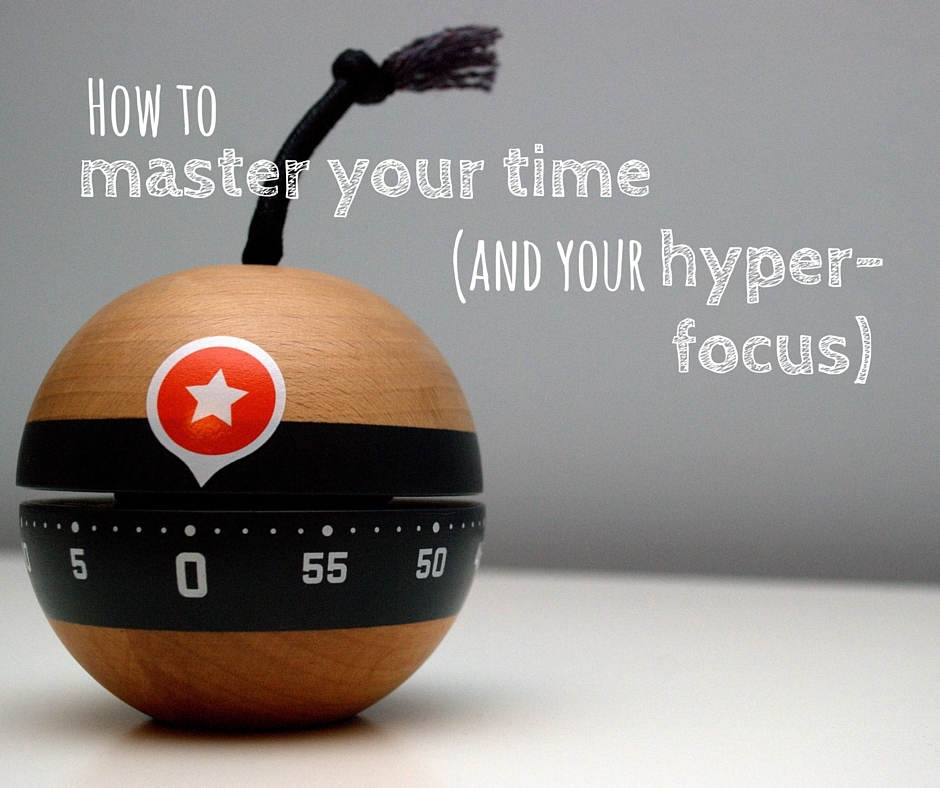People with ADHD can achieve almost superhuman levels of focus (referred to as hyperfocus) in some situations, yet none at all in others. That’s because ADHD isn’t an attention deficit, but a broken attention regulation system.

Hyperfocus is our secret superpower. Often, it’s also our undoing. Capable of an amazing state of flow, we’re unstoppable, and it’s easy to get ‘sucked in.’ That’s why it’s so important to reign in our hyperfocus: unstoppable even to ourselves, we become a runaway train…and we all know how that ends.
Unchecked, hyperfocusing ADHD’ers neglect all other responsibilities. Work, school, family, or romantic relationships may suffer. Health may decline due to frequent all-nighters and missed meals (have you ever gotten in the zone and forgotten to eat?).
The good news is, you can learn to let your hyperfocus run wild in a controlled environment. It’s not easy, but here are some tips to get you started.
Know your triggers and risky behaviors
Keep a log of activities that run away with you. What time of day was it? What else was going on?
Eventually, you’ll see a pattern. For example: I don’t particularly like sewing, but it’s one of the few projects that gets me out of control, always wanting to eliminate one more rough edge. When I’m tired or frustrated, I’m more likely to waste time on Facebook because my brain can’t get in gear.
Know yourself. Know when you’re more likely to lose control, even if you don’t necessarily feel like it’s a bad thing (“sure I went to bed at 3:00 a.m., but I got so much done!”)
Limit time spent on high-risk activities
In her habits book, Better Than Before, Gretchen Rubin tells us to “decide not to decide.”
In other words, set boundaries ahead of time and commit to sticking to them. For example:
- Only one one-hour or two half-hour television shows per night
- Never open Facebook after 9:30 p.m.
- Don’t start a new computer programming task within one hour of bedtime
Don’t let your brain talk you out of it. It will tell you things like:
- “If you just do this one little thing, you can get the program working”
- “If you sew this side seam, you’ll just have the bottom hem to do tomorrow”
- “It’s only 25 more minutes, and we need to watch the resolution of this cliffhanger.”
There will always be one more thing, even after that one more thing.
Decide not to decide.
You also need breaks — ideally, before you think you need them. Read up on the Pomodoro Technique, which advocates a system of regularly spaced short and long breaks to keep your brain functioning at its peak.
Set a timer. Don’t trust yourself to watch the clock, or even to remember time exists.
If you share an office space, you may want to use a desktop app like Tomighty. At home, we love Suck UK’s adorable — and very loud — bomb timer. The Time Timer provides an excellent visual representation of time, and its ending bell is soft enough to use in a shared space.
Whatever you do, get up and stretch for a few minutes every half hour or so. It’ll break the spell and remind you of the real world — and the people in it who count on you.
Enlist help
Make agreements with family, colleagues, or helpful friends. Tell them to be persistent, even if you resist, make excuses, or tell them to go ahead to the meeting and you’ll be right behind them. Agree ahead of time that this is unacceptable behavior, and ask them to remind you whenever necessary.
Also, remember: you’ve asked this person for their help and support because you’re struggling with self-regulation. Try to listen, cooperate, and be gracious.
Use gentle reminders that involve the senses
If you’re trying to break the spell of someone else’s hyperfocus, avoid getting angry. The ADHD person isn’t fully present in this interaction. They may not remember a conversation that occurs during hyperfocus, and they may not even notice anything happening around them.
Because hyperfocus takes us so deep into the zone, we often need more than a simple, “time to leave for dinner — now.” Create a sensory event to bring consciousness back to the real world. Turn the lights off, provide a gentle touch on the arm or shoulder, or set a timer with a loud bell. If an electronic device is involved, turn it off — but only if you’ve agreed beforehand that this is okay!
You can do this for yourself, too, especially if you invest in something like a WeMo switch or, if you want to go simple, a lamp timer that will turn off the lights or computer at a predetermined time. Apps and browser extensions — like the Productivity Owl for Google Chrome — can help limit time on specific websites.
How about you? Do you struggle with hyperfocus? What tools and tricks have worked for you?
Hey there! Are you enjoying The ADHD Homestead?
Here's the thing: I don't like ads. I don't want to sell your attention to an advertising service run by the world's biggest data mining company. I also value my integrity and my readers' trust above all, which means I accept very few sponsorships/partnerships.
So I'm asking for your support directly. For the cost of one cup of coffee, you can help keep this site unbiased and ad-free.
Below you will find two buttons. The first lets you join our crew of Patreon pals and pledge monthly support for my work. Patrons also have access to my Audioblogs podcast. The second takes you to a simple donation page to pledge one-time or recurring support for The ADHD Homestead, no frills, no strings. Do whichever feels best for you!

